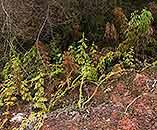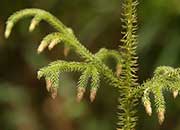Lycopodiella cernua (L.) Pic.Serm.
Synonyms |
Lycopodium cernuum L. |
|---|---|
Common name |
|
Description |
Main stem creeping on the ground for most of its length, rooting at points of contact with the ground, roots short, up to 10 mm long; secondary stems erect, much-branched, Christmas tree-like, densely leavy. Foliage leaves needle-like, 1.5-5 × 0.2-0.3 mm, entire, spreading and curving forward. Fertile portions borne in sessile, solitary, strobili, 4-15 x 2 mm, at the apex of drooping branches. Sporophylls pale yellowish, 1.5-1.8 × 1.2 mm, ovate in outline, apex tapering, margins not entire. |
Notes | Very distinctive drooping cones, should not be confused with any other fern. |
Derivation | cernua: drooping, nodding; referring to the hanging branch tips and strobili that make the plant look like a miniature fir tree. |
Habitat | Forest margins, Sphagnum bogs, riverine grassland, marshy areas along streams and in open sunny disturbed areas. |
Distribution worldwide | Tropical and subtropical regions of the world. |
Distribution in Africa |
Angola, Benin, Burundi, Cameroon, Central African Republic, Congo, Dem. Republic of Congo, Equatorial Guinea (incl. Bioko), Ethiopia, Gabon, Gambia, Ghana, Guinea, Guinea Bissau, Ivory Coast, Kenya, Liberia, Malawi, Mali, Mozambique, Nigeria, Rwanda, Senegal, Sierra Leone, South Africa, Sudan and South Sudan, Swaziland, Tanzania , Togo, Uganda, Zambia, Zimbabwe. |
Growth form |
Terrestrial. |
Literature |
|





